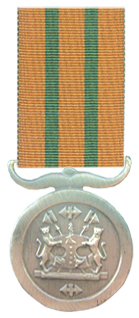
The Medalje vir Troue Diens - Medal for Loyal Service was instituted by the President of the Republic of South Africa on 16 April 2003 and came into effect on 27 April 2003. It can be awarded to all ranks whose character and conduct have been irreproachable and who have completed ten years of qualifying service.

The Dekoratie voor Trouwe Dienst, post-nominal letters DTD, is a South African military decoration. It was instituted in 1920 as a retrospective award for Boer officers of the 1899–1902 Second Boer War.

The Louw Wepener Decoration, post-nominal letters LWD, is a military decoration for bravery which was instituted by the Union of South Africa in 1952. It was awarded to members of the South African Defence Force for acts of the most conspicuous courage or greatest heroism. The decoration was discontinued on 1 July 1975, when a new set of decorations and medals was instituted.

The Van Riebeeck Medal, post-nominal letters VRM, is a military decoration for bravery which was instituted by the Union of South Africa in 1952. It was awarded to other ranks for distinguished service in the field.

The Military Merit Medal, post-nominal letters MMM, is a military decoration which was instituted in the Republic of South Africa on 9 October 1974 as the Chief of the Defence Force's Commendation Medal. It could be awarded to all ranks of the South African Defence Force for service of a high order.

The Pro Patria Medal is a South African military campaign medal which was instituted by the Republic in 1974. It was awarded to members of the South African Defence Force for service in an operational area, as designated by the Minister of Defence or for engagement in armed combat with the enemy.

The Unitas Medal was instituted by the President of the Republic of South Africa on 4 November 1994. It was awarded to all ranks who were on the active strength of all seven constituent military forces from 27 April 1994 to 10 May 1994, to commemorate their amalgamation into the South African National Defence Force. It was also awarded to personnel of the British Military Advisory and Training Team which served in South Africa at the time.

The Transkei Defence Force Medal was instituted by the State President of the Republic of Transkei for award to all ranks as a military medal for merit.

The Independence Medal was instituted by the State President of the Republic of Bophuthatswana to commemorate that country's independence on 6 December 1977. It was awarded to all ranks on the active strength of the Bophuthatswana Defence Force upon independence.

The Medal for Long Service and Good Conduct, Bronze was instituted by the State President of the Republic of Bophuthatswana in 1982, for award to all ranks as a long service medal for ten years service and good conduct.

The Medal for Long Service and Good Conduct, Silver was instituted by the State President of the Republic of Bophuthatswana in 1982, for award to all ranks as a long service medal for twenty years service and good conduct.

The Medal for Long Service and Good Conduct, Gold was instituted by the State President of the Republic of Bophuthatswana in 1982, for award to all ranks as a long service medal for thirty years service and good conduct.

The Marumo Medal, Class II was instituted by the State President of the Republic of Bophuthatswana in 1988.

The Defence Force Merit Decoration was instituted by the State President of the Republic of Bophuthatswana in 1982, for award to officers for distinguished service of high quality and utmost devotion to duty.

The Independence Medal was instituted by the President of the Republic of Venda in 1979, for award to all ranks in commemoration of the independence of Venda.
The State President's Medal for Shooting was instituted by the State President of the Republic of Bophuthatswana in 1990, for award to champion shots.

The Sandile Decoration, post-nominal letters SD, was instituted by the President of the Republic of Ciskei in 1988, for award to all ranks for meritorious service.

The Independence Medal was instituted by the President of the Republic of Ciskei in 1981, for award to all serving members of the Ciskei Defence Force on 4 December 1981 to commemorate the independence of Ciskei.
Rank comparison charts of armies/land forces of apartheid states and territories in Southern Africa.


















